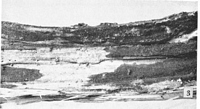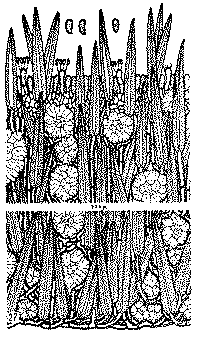|
 Hymenochaete dissimilis Hymenochaete dissimilis
BiostatusPresent in region - Indigenous. Non endemic
Images (click to enlarge)
Caption: P1. 3, fig. 3. Hymenochaete dissimilis G.H.Cunn. x ½. Closely adnate fructifications finely
colliculose in the upper portion. | 
Caption: FIG. 27. Hymenochaete dissimilis G.H.Cunn. Transverse section x 500; spores x 1000.
Showing masses of embedded crystals. |
Article: Cunningham, G.H. (1957). Thelephoraceae of New Zealand. XIV. The genus Hymenochaete. Transactions of the Royal Society of New Zealand 85(1): 1-51.
Description: Hymenophore resupinate, perennial, membranous-woody, adnate, following closely the
irregularities of the substratum, effused forming irregular linear areas 3-15 x 3-5 cm.
Hymenial surface sepia, chocolate or black when old, velutinate, deeply irregularly creviced;
margin abrupt, often cliff-like, adnate, concolorous. Context sepia, 300-750 µ thick,
composed of masses of setae arranged in overlapping rows, embedded in upright hyphae,
pseudoparenchymatous when old and containing numerous groups of coarse crystals,
abhymenial area reduced to a delicate cemented zone lying upon the substratum; hyphal
system dimitic; skeletal hyphae 3-4 µ diameter, walls 1 µ thick, golden brown, freely
branched, septate; generative hyphae 2-2.5 µ diameter, walls 0.25 µ thick, hyaline, branched,
septate. Setae projecting to 40 µ, subulate, 50-75 x 7-9 µ, walls naked or finely verruculose,
reddish-brown, lumina narrow. Hymenial layer to 30 µ deep, a dense palisade of basidia and
paraphyses. Basidia subclavate, 16-20 x 4-4.5 µ, 4-spored; sterigmata arcuate, slender, to 6 µ
long. Paraphyses subclavate, shorter and slightly narrower than the basidia. Spores
suballantoid, 4-5.5 x 2.5-3 µ, walls smooth, hyaline, 0.l µ thick.
Habitat: HABITAT: Effused on bark or decorticated dead wood of branches and trunks, associated
with a pocket rot.
Distribution: DISTRIBUTION: New Zealand.
Notes: Specific features are the coffee-coloured or chocolate surface, thick context composed
entirely of numerous overlapping rows of setae and masses of crystals embedded in upright
hyphae cemented to form a pseudoparenchyma; suballantoid somewhat small spores and
absence of a cortex and intermediate tissue. The species shows a general resemblance to H.
unicolor, and produces a similar pocket rot; it differs in surface colour, setal arrangement,
suballantoid spores, presence of masses of crystals and absence of definite strata. In a few
collections some setae of the hymenial layer are grouped in small fascicles of 2-5; in other
collections this feature is absent, so is not of diagnostic value. Setae vary in length in different
collections, in some being almost as short as those of H. vallata, in others exceeding slightly
the dimensions for those of typical plants. Plants growing horizontally upon the sides of
trunks become thickened on the upper margin, simulating specimens of slightly reflexed
species. Their margins are glabrous and black, and in sections show the typical thick setal
layer, so are evidently accidental growth conditions.
|